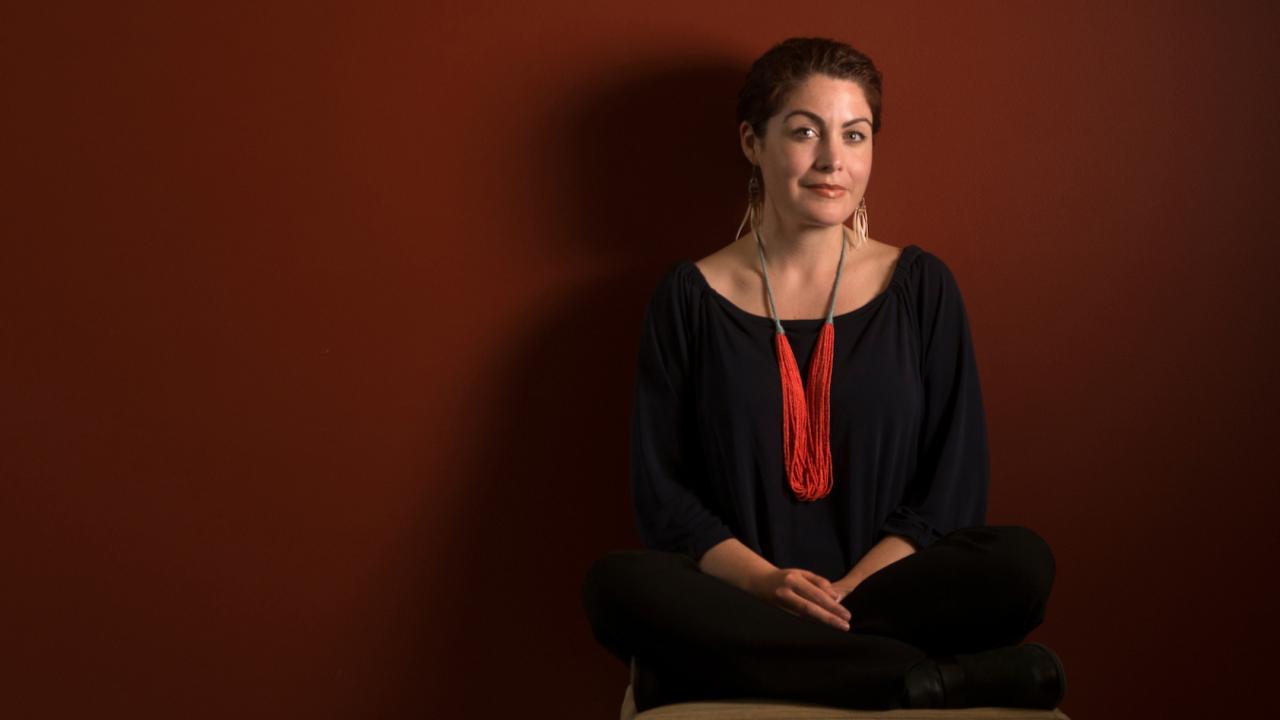
Discovering Curiosity: Art at the Zoo with Rebecca Calisi Rodríguez
“There is no specific path, only the path you make." - Rebecca Calisi Rodríguez
Before delving into the world of endocrinology, Assistant Professor Rebecca Calisi Rodríguez, Department of Neurobiology, Physiology and Behavior, wasn’t following the path of a traditional scientist. She’d studied studio art and psychology at both Skidmore College and Boston College and thought she wanted to pursue the artist’s life.
“When I graduated, it was really difficult to make it in the art world, but I would get odd jobs here and there,” she said. “One of them happened to be at the Dallas Zoo, where they commissioned me to paint this very large mural.”
It was there, among the zoo’s fauna, that Calisi Rodríguez discovered her love for scientific research. And it all started with a mysterious animal behavior.
The okapi and the mural
The zoo commissioned Calisi Rodríguez to paint a mural on the inner wall of the Wilds of Africa Education Center. It took her a couple of months to paint a vast African savannah scene, featuring lions, elephants, cheetahs, zebras and more, and Calisi Rodríguez spent a lot of time at the zoo. During breaks in her work, she’d explore her surroundings, a cup of tea in hand and the sounds of the wild as her personal soundtrack.
“That’s when I came across the okapi, an animal that changed my career path forever,” she said.

Related to the giraffe, the okapi is visually striking. Its white and black striped legs give way to a chocolate-colored body; its long and articulate tongue, like a giraffe, probes about; and its ears are upright, as if always at attention. An endangered species, okapi are native to the tropical rain forests of the Democratic Republic of Congo. Though current population size estimates aren’t reliable, the total population is believed to range between 10,000 and 50,000.
At that time, the Dallas Zoo was known as having one of the best conservation breeding programs for okapi, according to Calisi Rodríguez.
A mystery at the zoo
But there was a problem. That year, the zoo’s okapi stopped breeding. Baffled scientists enrolled volunteers to help decipher the mystery. Intrigued, Calisi Rodríguez jumped at the opportunity. She wanted to touch the okapi’s velvety fur and bask in its exotic majesty. The reality was different.
“They handed me a stick attached to a cup and said, ‘Every time it relieves itself, we need you to collect the urine,’” said Calisi Rodríguez. “That was my glamorous job. So I would collect okapi pee, record which animal it came from and rush it over to the lab.”
In the okapi urine, the scientists found increased levels of the hormone cortisol, which usually signals an animal is under stress.
“This is important because cortisol helps the body utilize energy resources needed to deal with that stressor and survive,” said Calisi Rodríguez. “And if you have too much cortisol for a chronic period of time, it can start to wear out different systems in your body.”
This includes the reproductive system, which could’ve explained the lack of breeding in the zoo’s okapi population. So the question became, why were the Dallas Zoo’s okapis stressed?
“Eureka!” A life-changing moment
As Calisi Rodríguez remembers it, around the time the okapi stopped breeding, the Dallas Zoo had installed a new manure handling system at the opposite end of the park. Designed like a conveyor belt, the new system carted manure away from the holding pens.
“The scientists thought that the okapi—being very sensitive animals—might be detecting the vibrations from the machine and those vibrations might be stressing them out,” said Calisi Rodríguez.
The zoo shut off the system. Eventually, the okapi cortisol levels decreased, and the animals started breeding again. For Calisi Rodríguez, watching the scientists resolve the mystery became an “Aha!” moment.
“I felt like I was Dr. Dolittle because the okapi were talking to us and telling us they were stressed out,” she said. “But they were doing this through their hormones. I had to learn more.”
Inspired by the experience, Calisi Rodríguez’s career ambitions shifted. She wanted to take on the role of a detective, uncovering mysteries of the natural world around her. She returned to school, earning an M.S. in biology at University of Texas, Arlington and a Ph.D. in integrative biology at the University of California, Berkeley. Despite the career shift, Calisi Rodríguez never left her passion and training as an artist behind.
“These experiences strengthened my ability to see the unseen and attack projects creatively,” she said. “All scientists are in many ways artists, and all artists, scientists.”
A career through the ranks of science thus began. She worked as a National Science Foundation postdoc in neurobiology, physiology and behavior at UC Davis and UC San Diego and as a UC President’s postdoc in psychology and environmental science and policy management at UC Berkeley. In 2014, her career took her to the East Coast, where she became an assistant professor of biology at Columbia University’s Barnard College. But an assistant professorship offer at UC Davis soon lured her back to West Coast.
Today, Calisi Rodríguez can look back at her experience at the Dallas Zoo and directly relate it to her work. Part of her continuing research is understanding how stress and other environmental factors affect animal reproduction. She uses pigeons as a model organism, which help represent similar biological processes in all vertebrates, including humans.
Her own unorthodox path to UC Davis has convinced her that there is never a set roadmap to any career.
“There is no specific path, only the path you make,” she said.